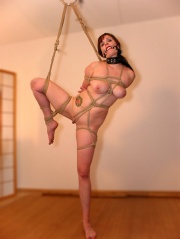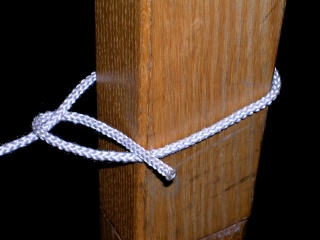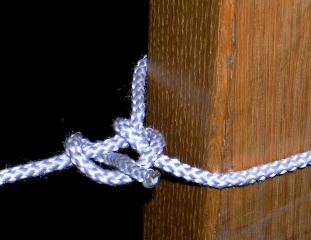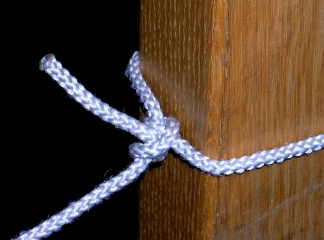 |
Peter Masters |
Peter Masters |
|
|
|||||
| About me | About this site | My books | |||||||
Rope bondage
| Bondage articles | |
| Rope bondage | Predicament bondage |
| Rope bondage (functional) | Suspension bondage |
| Rope bondage (decorative) | Mummification |
| Rope harness | Breast bondage |
| Metal bondage | Hog-tie |

Figure 1. Rope bondage
© Raimond Spekking / CC-BY-SA-3.0 (via Wikimedia Commons)

Figure 2. Japanese-inspired bondage

Figure 3. Woman in hog-tie with ankle strain distributed between head harness and rope across the upper torso

Figure 4. Asymmetrical suspension rope bondage
Rope bondage is a type of bondage where the primary material used to restrain the submissive or bottom is rope.
At first glance, the purpose of rope bondage might seem to be to immobilise the submissive, as in figures 3 and 4. Figure 3 shows a hog-tie and, in this case, immobilisation is exactly the point. For the submissive, the sense of restraint is total and she cannot move at all. She feels the tightness of the rope and she has very few ways possibilities of movement.
Figure 1, on the other hand, shows rope bondage which encloses the torso and arms, but which leaves the head free and legs free except for a pair of ankle cuffs. This is not tight bondage and it allows the submissive some movement (for example, she can kneel, or she can slowly shuffle from one place to another). She does remain, however, largely helpless.
Figures 2 and 4 show more stylistic rope bondage and some effort has clearly been made in regards to presentation of these displays. Figure 4, in particular, is immobilising rope bondage. The submissive is tightly held in position, and is held up on her left leg by the ropes going to the anchor point above her.
Note the two ropes passing between her legs, pressing on either side of her labia. This can give a very strong sexual sensation.
We can see in these few examples that rope bondage can be split into two types based on the intent behind the bondage:
- Decorative bondage, where the appearance of the resulting tie is most important, or
- Functional bondage, where the elements of restraint and utility are most important.
Knots
Of course, one of the key techniques in rope bondage is tying knots. There are many different sort of knots which can be used in rope bondage, and the figures on this page show a variety of them in use.

Two half hitches - step 1

Two half hitches - step 2

Two half hitches - step 3
Because of the wide variety of circumstances and positions in which knots are used, there is no single universal BDSM knot. Different knot suit different circumstances. For example, on the lower right of this page you can see a series of three pictures showing how to tie what is called "two half hitches". This knot is ideal when you want to tie just one end of a rope to something, such as when you want to tie a submissive spread-eagled to the four corners of a bed.
In all cases when performing rope bondage, it's important to keep a pair of trauma shears handy in case you need to quickly release your submissive